|
|||||
FlyingRC.net is a
Veteran-Owned site.

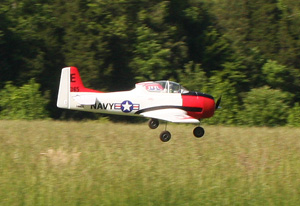 |
The T-28 is part scale, part trainer and part sport plane. With a good instructor and a buddy box the T-28 can replace the first high-wing trainers for many people. Click image to enlarge |
T-28 Trojan by ParkZone
A bit of scale, trainer and sport in one plane
Text by Tom Hintz
Photos & video by Beth and Tom Hintz
Posted – 5-29-2013
An upcoming event at our flying club where a group of kids were being brought out to experience radio control flying got me thinking about the T-28 Trojan and how it would serve these novice pilots on a buddy box. I had heard about its docile demeanor plus it has tricycle landing gear and the wing had a good amount of dihedral which should help keep it on track during landings in moderate winds.
I know the traditional thinking is to use high wing planes for trainers but I am convinced that this electric-powered foamy would handle training chores with the help of a buddy box and be able to give the learning pilot the next step once they learned the basics. So off to the hobby shop to grab a BNF (Bind and Fly) version of the T-28 Trojan and a Spektrum DX6i that would pair up with my existing DX6i for-buddy-box chores.
The Basics
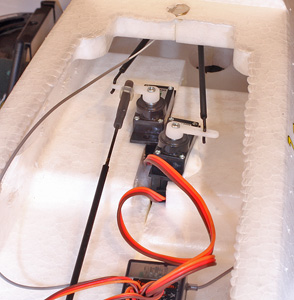 |
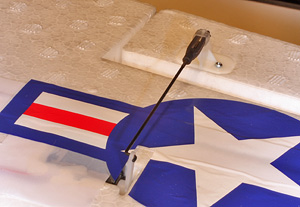 |
This is BNF plane, Bind N' Fly which means that it comes with the radio gear (left) already installed and set up. You need to pro9vide a compatible transmitter. I like that they used individual servos at each aileron. (right) Click images to enlarge |
|
The T-28 Trojan weighs in at a trim 30 0z flying weight balanced along a 36”-length and a 44”-wingspan. It is powered by a factory installed electric 480-size 960Kv brushless outrunner motor. The motor is controlled by an E-flite 30A Pro Brushless ESC (electronic speed control) that with Switch Mode BEC (battery elimination circuitry, negates the need for separate receiver battery). Power is provided by an 11.1V 3S 1800mAh Li-Po battery (1 pack included) and a 2-3 Cell DC Li-Po Balancing Charger also in the box. The standard prop size is 9.5 x 7.5.
A Spektrum AR600 DSMX 6-channel sport receiver is factory installed as are a pair of Spektrum DSV130M servos for the rudder (and nose wheel) and elevator and two SV80 Long Lead servos one at each aileron.
What you need to fly the T-28 Trojan is a compatible a full range DSM2 or DSMX aircraft transmitter, 4-channel minimum. My Spektrum DX6i fits that bill easily. Realistically, you will need a few extra battery packs for a decent day at the field but aside from that the T-28 Trojan really does come complete.
The T-28 Trojan is made from tough, durable, lightweight and easy to repair Z-Foam™ that holds its shape well. As with all foamies from ParkZone individual parts are available and surprisingly low-priced should a flight end more abruptly than anticipated. Though I have not crashed my T-28 Trojan at speed I did manage a nose-down thump while exploring the aerobatic capabilities of the T-28 Trojan at far less altitude than was required. The damage was limited to a broken prop and putting the cockpit back on. A nice feature of this kind of foam construction is that simple breaks and dings can be repaired with any medium-viscosity (foam-friendly) CA or epoxy.
The T-28 Trojan comes with 1-7/8” wheels on it that seems to be perfect for paved surfaces. Our field is grass and though in very good condition it does have the occasional dip and bare spot. I opted to swap out the original wheels for some DuBro 2-1/2” super light wheels/foam tires that seem to be a bit lighter than the original wheels but should decrease rolling resistance considerably.
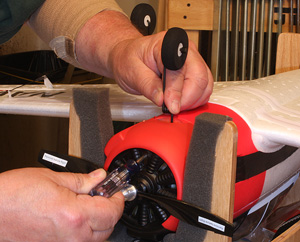 |
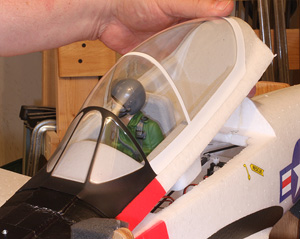 |
The nose wheel (left) is steerable which helps new pilots on the ground. The cockpit (right) is held in place magnetically so you have quick access to the battery and inner workings. Click images to enlarge |
|
In the Air
I “maidened” (first flight) my T-28 Trojan on a blustery day with 10 to 20 mph winds that felt to be gusting higher yet. I took it to full throttle and kept it headed into the wind and after 30 feet or so jabbed some elevator to get the trike gear out of the grass. The T-28 Trojan flew out easily but needs a little time to build up to full speed. Once it in the air it handles fine and can easily fly at part throttle in reasonable wind conditions. In the relatively heavy winds of that first day the T-28 Trojan did like to carry ½ to ¾ throttle to remain stable on the downwind turns and did get bounced around some by the typically heavy turbulence at one end of our field. While the bouncing was noticeable I never felt like I was losing control.
On landing in the gusty winds the T-28 Trojan was very well behaved. The dihedral goes a long way to settling this plane down. Plus though the CG (center of gravity) was as specified it seems to have a tendency to drop the nose slightly which helps keep the power-off airspeed up. Hold just a bit of elevator and the T-28 Trojan sinks in with the trike gear level with the ground.
The trike gear worked well but the lightness of the T-28 Trojan in the gusty winds produced some odd three-point stances after landing when I tried to turn back to the pits. The tail would get the wind under it and the T-28 Trojan would go up on one main wheel, the nose wheel and the spinner providing the third point of contact. If we scaled the winds experienced this day up to the plane this would be a lot like trying to taxi the 100-percent version in a 100-percent hurricane. This tipping in the gusts is not an issue with the plane, just physics.
Over the course of 8 flights that first day I did some tweaking of the control surfaces and followed that with several more flights on a calmer day to make final tweaks to the control surfaces. All adjustments were small which shows the factory prep was very close to perfect. Since then the T-28 Trojan has remained trimmed and continues to fly well.
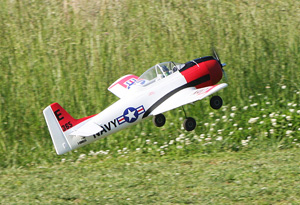 |
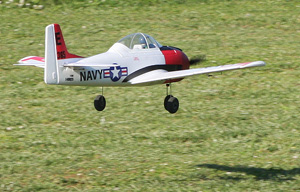 |
The T-28 Trojan handles rookie-like abrupt takeoffs (left) as well as any sport plane. Later when it comes time to land as in this photo (right) when the wind is howling more than we would like the T-28 Trojan settles in nicely with a little practice. Click images to enlarge |
|
Conclusions
The T-28 Trojan is a nice plane for a wide range of pilot experience. It doesn’t fit the traditional high wing trainer school of thought but with today’s buddy-box systems and the stability of the T-28 Trojan I think it is possible to skip that first high winger. With a slightly longer learning curve novice fliers can handle the T-28 Trojan easily and have a plane capable of basic aerobatics. Being able to take that extra step with the T-28 Trojan saves the new pilot money and extends the usefulness of the first plane substantially.
With a street price of $239.99 (5-29-2013) for the Bind-N-Fly version the T-28 Trojan is a very good value for new and veteran pilots alike. This is a solid little plane that handles reasonable winds with ease and can withstand the bumps and bangs of the occasional “inappropriate landing” everyone seems to do now and then.
See the T-28 Trojan product page – Click Here
Have a comment on this review? – Email Me!
Video Tour |
|
All Flyingrc.net written, photographic and drawn materials are property of and copyright by Tom Hintz and Flyingrc.net 2013-2020 Materials cannot be used in any way without the prior written permission of the owner.
Privacy Statement


